As an Amazon Associate I earn from qualifying purchases.
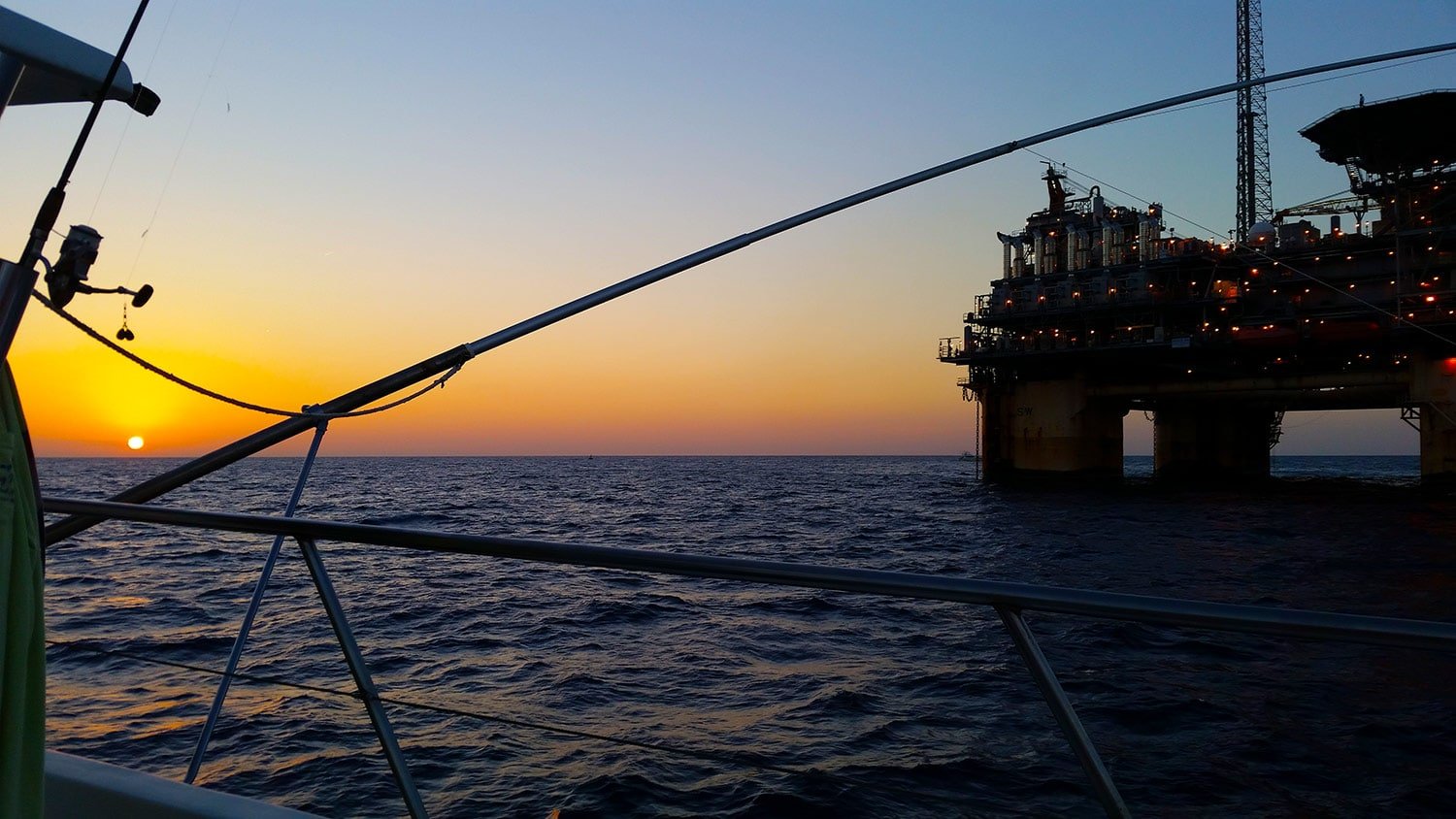
The clatter of lead butterfly jigs on the steel deck of the F/V Escape jarred me out of a wave-rocked slumber.
I glanced at the time: 3:55 a.m. The sun wouldn’t rise for nearly two more hours. Over the past 12 hours, Capt. Skipper Thierry had been motoring more or less southwards from Dauphin Island, Alabama, before he’d hit this tuna spot about 110 miles offshore, near a gigantic oil rig.
The rig was a sight to see. I’d never been this close to one before. Noisy, clanking with machinery, the rig was lit up like Broadway on New Year’s. Atop it was a huge spire belching roaring flames burning off hydrogen sulfide, a byproduct of oil drilling. It reminded me of the Eye of Sauron from Lord of the Rings.

Deckhands Chris and Chad, along with my friend Joe Baya, who served as a deckhand aboard the Escape for seven years before becoming the publisher of the magazine Great Days Outdoors, started setting up an array of massive tuna rods on the stern. Chris began flipping chunks of menhaden, an oily bait fish, overboard, while Joe and Chad slowly let out other chunks of menhaden attached to hooks — the idea being that the chum slick attracts the fish, who hopefully bite a chunk with a hook in it.
I shuffled out to the deck along with nine of my fellow anglers, all groggy, most clutching Styrofoam cups of inky coffee.
We’d all drawn straws the previous night to establish rod positions; I’d drawn number nine of 10, so I would not get near those big tuna rods until almost everyone else had either caught or lost a fish. So I settled next to a much lighter rod with one of those butterfly jigs attached to it; a butterfly jig is so named because it flutters downward after you yank the rod skyward, looking like a wounded bait fish.
To work this jig, you let out line and count Mississippis — each Mississippi equating to roughly 10 feet — until you get around where Skipper said he’d marked fish. Then you jerk the jig upward and let it float down; most bites come on this downward flutter.
Within minutes, John, a Mobile local, hooked a fish on my left. Definitely a tuna. And it was big. John is no small man, and this tuna was dragging him all over the boat. But the hook held, and Chad gaffed up the fish, a big yellowfin that would weigh in at 90 pounds. On the board!
Other anglers soon connected with smaller blackfin tuna, and the back rods hit again and again. Soon I’d get my turn!
My jig stopped abruptly, like it was hitting bottom. Only the bottom was 7,000 feet below me. I set the hook — fish on! It felt like a nice blackfin, maybe 20 pounds.
Tuna, if you’ve never caught one, are strong all out of proportion to their size. They are athletic aqua torpedoes that can reach speeds of 45 miles per hour in the water. This tuna buttoned to my line was testing that. I could only watch as it peeled off 50 yards of 80-pound braided line. Catching a tuna is a contest of determination between angler and fish, a test of your ability to finesse to the boat a fish that can break you off in a heartbeat, snap your knots, straighten your hooks, spool your reel… or just wear your ass out.
Fortunately for me, this first fish wasn’t up to the tough tackle I was using, and I soon brought him (her?) to the surface. I spotted a luminous flash in the crystalline water — and then watched in horror as a huge, gray shape whizzed by, snatched my tuna and was gone.
Dolphin. Bottlenose, I think. Damn. DAMN! Oh well, I figured, there’d be another.
And then the bite stopped.
Maybe it was the dolphin, who probably had lots of friends around we couldn’t see. We kept at it for an hour after sunrise, with no success, then switched to trolling. This would be our fate for most of the long day ahead.
Tuna fishing is an exercise in managing discomfort and disappointment.
With a few exceptions, a tuna trip requires at least a full 24 hours to pull off, and more is better. Proximity to their waters is only part of the issue; most tuna prefer blue water far offshore. The other factor is finding a school of tuna in the vastness of the pelagic sea. Deep water is often a watery desert, with fish constantly swimming in search of a little bit of food here, a little there. In the Gulf of Mexico, oil rigs serve as oases in that desert.
They concentrate fish by serving as man-made structure for everything from shellfish to plankton and on up the food chain to tuna and billfish like marlin. But even so, not every rig will have fish at every moment. So you find them by motoring from rig to rig, hour after hour.
I’ve written about the state of zen required to successfully troll for salmon before, but tuna trolling is something else altogether.
With salmon, you “work your gear,” checking things constantly. Remove jellyfish or seaweed. Check for “drive bys,” glancing short strikes on the cut herring or sardines. Changing depths. Generally watching one rod.
With tuna, you are largely trolling artificial lures, and there is so little in the way of seaweed and jellyfish out in the blue water that the lines rarely get fouled. And with the system we’d chosen, only the angler whose number was up, and his successor, needed to be even semi-awake for it.
After the quick dawn, we’d stalled at angler number five, John’s friend Jim, who’d we’d dubbed the Ginger Ninja because, well, he is red-haired and fair-skinned, and because he wore several styles of sun-blocking facemasks. Hour after hour he stood guard. Hour after hour, nothing.
Most of us drank beer, traded fishing stories or slept. I did all three. Getting to know a dozen guys you’ve never met on a boat for 48 straight hours requires some tact. Chances are you all come from different backgrounds, different places, different politics. That’s why trading fishing stories is the lingua franca of boat talk; it’s safe, something we all share in common.
Some guys (there were no women on this trip) you click with immediately and later become friends with off the boat. Some you are perfectly happy to be around, and would gladly fish with again. Some you tolerate. Some you contemplate pushing overboard. Thankfully on this trip, everyone fell into the first two categories. And in all honestly, it’s fairly rare to get a real donkey on board. Not sure why, but it could have to do with the act of fishing itself, which is a humbling pursuit.
Joe’s brother-in-law Seth, whom we took to calling “drunk Thor” (a name he said he’d been given at his local bar), was up after the Ginger Ninja. Trained as a meteorologist, Seth really does look like Thor: A giant of a man, he sports long, blond hair and a blond goatee and is prone to walking the deck with no shirt and a beer in his hand. Several of us were secretly hoping he’d get a giant bluefin or somesuch on his turn at the reel, so we could see just how strong this dude actually was.
Alas, it didn’t happen.
Sometime in late afternoon, Jim the Ginger Ninja got his bite, a nice yellowfin of about 50 pounds. Seth’s turn at the big reels produced only a nice blackfin. Another yellowfin came aboard, then a couple more blackfin, until finally it was my turn at the rod.
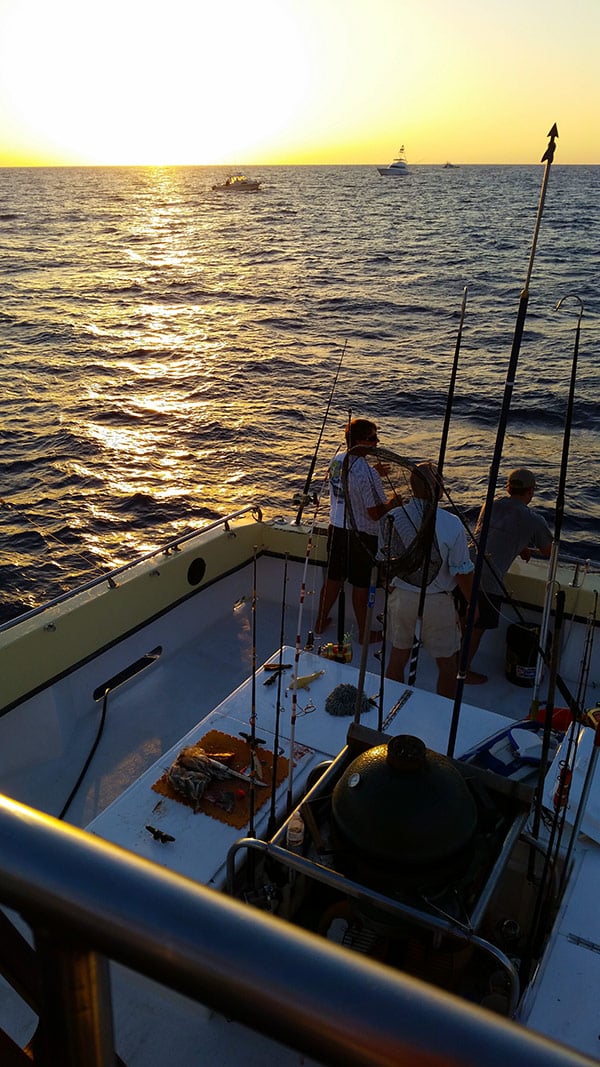
Chad handed me the screaming reel and I started fighting the fish. This huge tackle was a lot smoother than the jigging rig I’d been using all day. But soon I realized that the fish on the other end of the line was no giant. In a few seconds I saw it. Little blackfin? Not even. It was a kind of jack called a rainbow runner. A nice eating fish, but alas, the deckhands needed it for bait.
I’d be lying to you if I said I was not disappointed. With fishing this slow, the chances of me getting on the stern rods again was about nil. But the sun was setting, and everyone’s hopes lifted. Night bites are better, they all said. So I remained guardedly optimistic. Maybe I’d repeat John’s feat of landing a big yellowfin on the jig?
Back at the jigging rod, I soon had another bite, a small blackfin. I thought small because about halfway up, it stopped fighting. Huh. I brought the fish to the surface, and… goddamn it, again! The blackfin was just a head. Eaten, we think, by a barracuda.
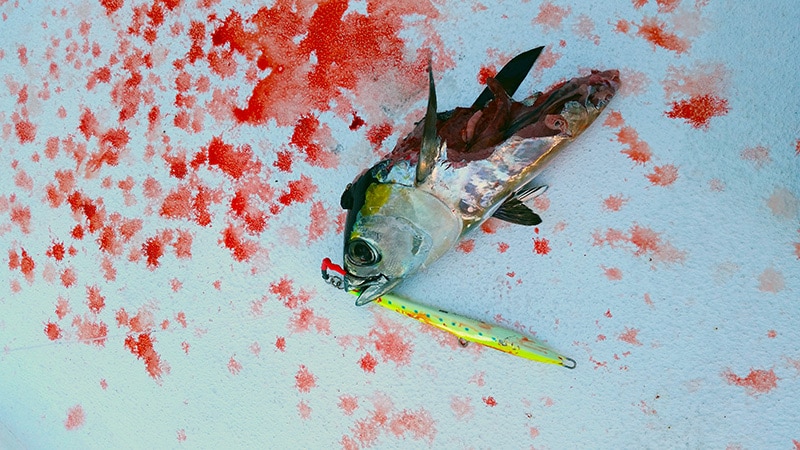
This was getting ridiculous. What had I done to anger the Fish Gods? Nothing to do but keep at it.
On into the night we fished.
My arms and shoulders were howling from more than 12 hours’ worth of jigging. My feet sore from walking the deck since 4 a.m. — turns out I’d walked three miles, according to my pedometer. Even though I’d slathered sunscreen all over me several times, I was feeling the burn of the sun.
Still I remained hopeful. Fishing, foraging and hunting are, with the exception of faith in a higher power, the most hopeful of all human endeavors. Just one more drop, one more hour of jigging. It’ll happen, I told myself. It. Will. Happen.
And it did. I got another bite, probably a nice blackfin. Nothing earth-shattering but bigger than my eaten head of a fish from several hours before. They say the tug is the drug, and I’d been in full withdrawal for most of the day. This zipping little tuna was the fix I needed.
I got it to the boat, Joe gaffed it, and finally I had a tuna.
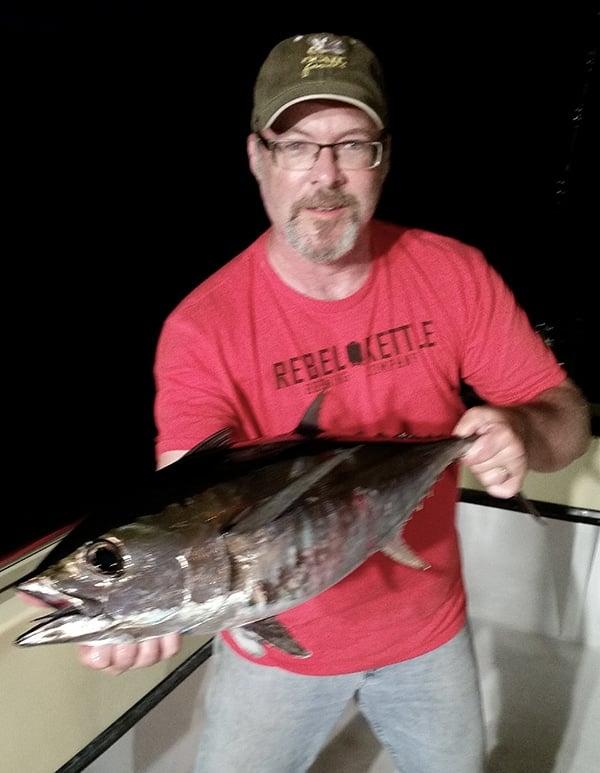
I looked at the time: 8:44 p.m. Sixteen hours and 55 minutes after I’d started fishing. I cracked a beer in celebration.
Still we fished on. Everyone, even the deckhands, was getting groggy. But our luck had to change. Had to. Right?
Shortly after midnight, my rod was nearly torn from my hands by something big. Something serious. The braid on the reel hissed as the fish tore it off 10 yards at a time. Yellowfin. Definitely a yellowfin. This was it, my chance at last! Lift, reel down. Lift, reel down. The fish dragged me toward the stern. Lift, reel down. Another sizzling run.
Foot by foot I regained line. The clank of a nearby oil rig rang in my ears. Up the fish came. A flash of color! Yellowfin!
Pop.
Gone.
I just stared into the black deep. No words. Nothing left. I reeled up the last few yards of line and looked at my jig. The hook had been bent outward by the force of the fish. I quietly put the rod in the holder and walked to the bow. No one talked to me. What was there to say?
I stared into the blackness, at the glimmering stars above, the fiery beacons of distant oil rigs dotting the horizon. I rode that bow for a long while, until I heard the clatter of butterfly jigs again. We were done. Defeat. Skipper told us he’d motor in all night and take us bottom fishing in the morning. Maybe we could catch some grouper.
That’s it then. That’s fishing. You swallow hard days like this, catch what sleep you can, lick your wounds and head right back at it next chance you get.
Because the next drop, the next troll, the next cast could be the one that links you to the next fish that will buoy you through the next day like this one.

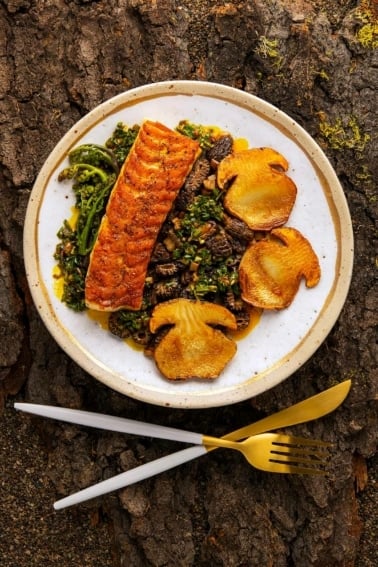
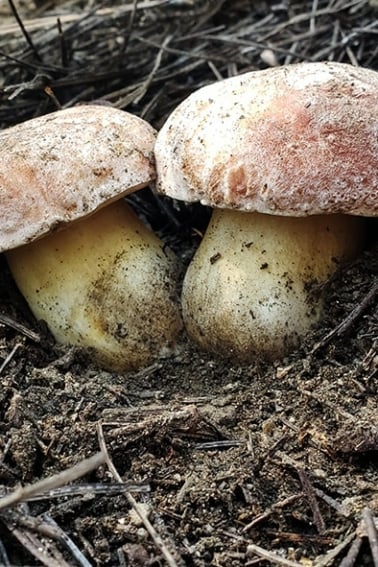
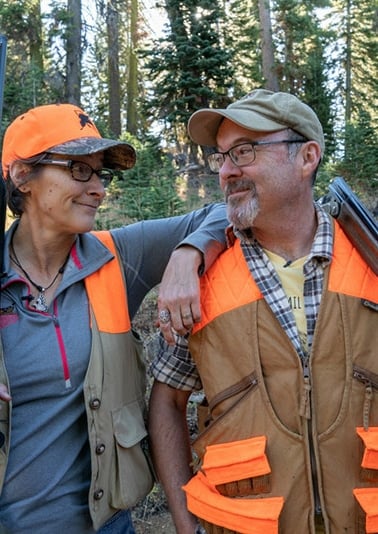
Good God you’re a wonderful writer, so evocative. Keep up the adventures, it’s inspiring enough to plan something for myself this summer
Mimi is right. Come up to the PNW and get some albacore. You’ll be writing about the long hours of processing fish.
Thanks for a good read.
Mark
Fun read! Some days fishing sure are an exercise in Zen. Can’t wait for some tuna recipes!
I loved my first tuna trip out here on the west coast of Washington last year, albacore tuna, great time and much shorter day. The fish is really tastey too. We even use it for sushi, rolls and nagiri.
I highly recommend it if your goal is to fill the freezer and do some canning. We’ve got a spot open on the boat this year too 😉
I enjoyed your take on my favourite fishing. I have a buddy in Louisianne who has taken me offshore and my gal offshore and introduced us to the world of yellowfin under the floating rigs out in the deep blue waters. The wire line, butterfly jigs, the chum churn, bump trolling live baits with no weight. I love tuna fishing. Big yellow fin or the more numerous and smaller black fin.But the very back is when the tuna come to the surface after flying fish.”Busting” my Cajun friend calls it. Same wire line spinning rig now throwing surface plugs and hard pulling retrieve, imitating the flying fish. Oh man that is the best of the best. Thanks Hank.
Hundreds of dollars, thousands of kms and many, many grueling hours perched on the rocky headlands of the east coast of NSW over the last 4 months. . One delicious speedster hooked and landed.
But you know what? I got smoked and canned tuna for 12 months. . And next season ill be back, and again and again until my knees give out and I have to buy a boat!
But that’s fishing hey? You either get it… or you dont.
Nice read and some nice shots,
Made my day.
Cheers Hank
The thrill of victory and the agony of defeat, is what keeps me on fish.